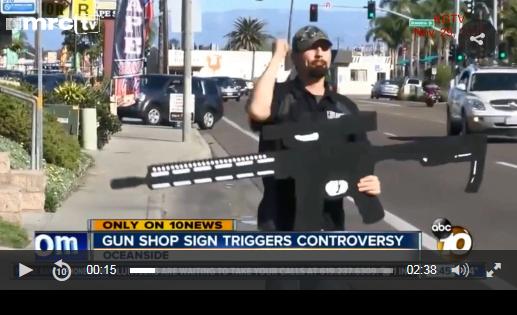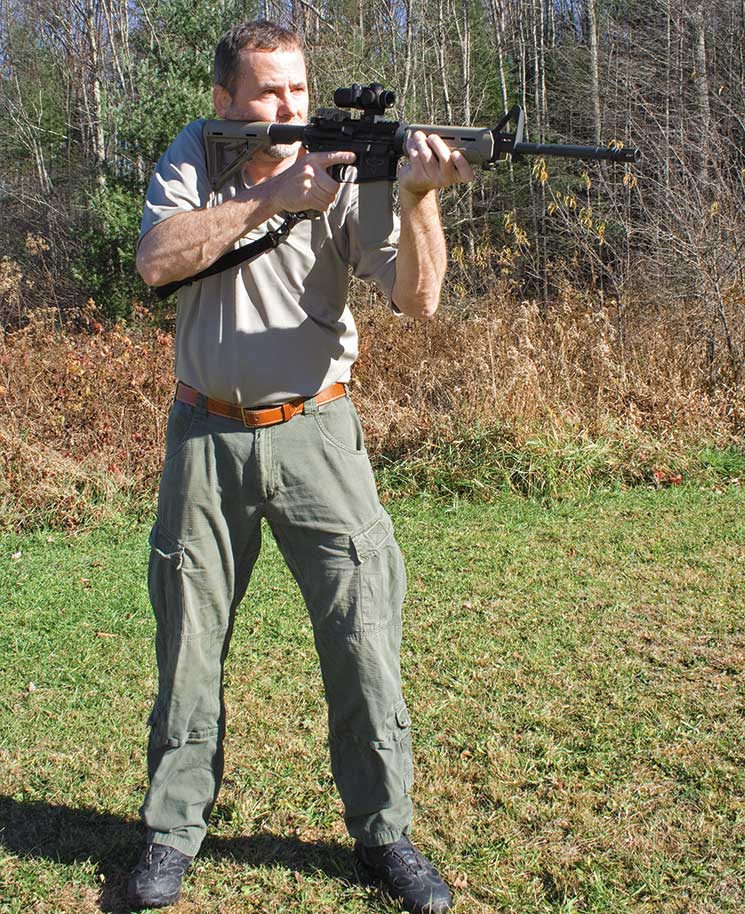In The Army Wants A New Rifle, we discussed my view of the Army’s searching for a larger caliber rifle to replace the M4. Experience in Afghanistan is the pretext for this need, and while as I show below I support a copious choice of weapons, selection of a different caliber won’t make marksmen out of Soldiers. In fact, perhaps just the opposite. You can go read the discussion for yourself. I hope I’ve adequately dispelled the ridiculous notion that The Battle of Wanat is justification for anything at all except being smarter in the future in your COIN strategy.
Soon after this commentary, a active duty friend who has been with me for nearly ten years (basically ever since I was doing military blogging and commentary) and who can tell you more about these things in an hour than I will ever know in a lifetime, wrote to continue the conversation with me. I am always richer when he does so, and honestly, this is one big reason for writing. I always learn more from my readers than they learn from me.
I will not supply his name, but as you can see below, we build on our notes to each other like Lego blocks, and always have. Each subsequent note presupposes that I recall what he told me before, which is usually a lot. There are notes that preceded this one, on shooting uphill, mountain training of soldiers (which he knows a lot about), and various and sundry things. But even in the absence of those notes, you may be able to benefit from his knowledge.
One “Lego block” that I didn’t add yet was that while he heaps praises on the Marine Corps shooting program, I think the MC could take a page from the army on a few things. The MC still has in its stable of DM and sniper rifles the 5.56mm, 7.62mm, and Sasser .50. When Carlos Hathcock did his work in Vietnam, he used the Winchester 30-06 (not the .308), which has a slightly higher muzzle velocity, and when that wasn’t sufficient he used the .50. He was the first to do so.
When something works, it’s difficult to get the MC to change. But their shooting program might benefit from inclusion of the .300 Win Mag and the .338 into their stable of weapons. I know one Marine Corps Scout Sniper, in impeccable condition, his physique a literal specimen, who told me that in not too many rounds shooting the .50, he had headaches. Why do this if it isn’t necessary?
Again as you can see, I support the inclusion of many weapons and weapons systems in the stable of tools for both the Army and Marine Corps, but I will never jettison my trusty AR-15 for CQB and medium range shooting. With that said, here is our exchange of notes.
As ever, my congratulations to you for your tireless efforts on your Blog. You are still slamming them!
I read your “Army wants a new rifle” post with interest. I have a little different perspective. Nothing you say is wrong or incorrect. How could it be? You are more emphatic of late in general and no less here. I’ll explain myself, but I do need to admit that I think that the Army is full of shit on this issue, in general and will do something or nothing in this case, for all the wrong reasons.
I’ve tested a lot of gear for the U.S. Army over the years. The Army has a civilian in charge of boots and boot development. He’s a huge, overweight man who wears worn loafers on his own feet. But he has a Doctorate in “footoligy” or some such thing and a very keen understanding of the politic’s of procurement. Our relationship with this idiot got so shady that he would bring bullet headed body guards with him to attempt to shut I and my peers up. So the Army has garbage boots because that is what they want.
I’ve tested and trained and conducted training on lots of weapons too; long arms, sniper rifles and the full suite of Warsaw Pact weaponry. My favorite is the SVD with the wacky Soviet scope; it’s quick, easy to shoot, accurate and people are scared of it. The RPD is an LMG that is greatly underrated. That is because the “PiKa”, Pkm, PK, is so dominant. I cannot say enough good things about getting hosed down by this bad boy. It is a real attention getter! Even beyond it’s 600m sweet spot, its plunging fire is stunning. The 240B is a honey but the Pkm has it beat for down and dirty warfighting.
5.56 v/s 7.62; ask a man who has taken 7.62 rounds into the chest or back plates, who also has the experience of dumping 5 or 6 rounds of issue 5.56 into an enemy to stop him. He will tell you that one 7.62 round in the plates will knock you down now and that the 5.56 will not return the favor. A few of the high-speed-low-drag elements get special 5.56 rounds that are one-shot-one kill specials. Our General Purpose forces don’t get this round though.
The Marines have established in their 24-72 hour protracted, static, fire fights in Southern Afghanistan, that three 30 round magazines will do the job, if you have NCO directed, well aimed and properly spoted fire. Shoot from cover, control your security and do not allow an element to maneuver unobserved on your position. Maintain indirect fire back-up for surprises and to exploit enemy error’s. It sounds basic but we do not routinely practice this doctrine. So we kill and maim our troops because of and regardless of, the grain count of our issue rounds. As you point out.
I’ve trained lots of guys to shoot both 5.56 and 7.62 in all sorts of long arms out to 1000m and lots of it on a high angle range; aim low, practice shooter spotter and get your point of aim and point of impact details worked out ahead of time. I can teach an experienced and confident soldier to shoot an Acog equipped M4 out to 600m with an hour of class room time and with 30 rounds on the range. He will of course have to practice these new shooting skills to develop their value.
I cannot train an inexperienced and unconfident shooter in this ridiculously brief time span and round count. In fact I’ll make him a worse shooter because he will do so poorly and understand zero of what I’m telling him. Even shooter/spotter will blow his mind. The exception here is with young Marine’s. They can often hang enough to get in their heads what is going on.
If you give me a 7.62 round weapon, even the M14 variants kicking around, and a little more time; I can get the confident guy consistently out to 850m. He’ll be able to read bullet trace, call his shots and walk a less experienced shooter quickly on to a target.
Good for me, so what. Hopefully the details are instructive. Again, as you point out, unless there is a solid grounding in the fundamentals of marksmanship, and or well trained NCO leadership in all our maneuver units; we may be better equipped to kill if we carry spears. We can conduct the training. But our Army does not currently know how to train, so maybe new magic rifles with new magic rounds are the answer.
Thank you,
[Name Redacted]
I respond.
Very good to hear from you. I like the MC idea of a number of DMs who have something a little different. My own son was trained as a DM even though he was a SAW gunner. [But] The notion the new 7.62 guns will make all soldiers marksmen is overreach versus what big army management wants. Too many poorly educated kids from homes with no fathers who look to the *.gov for a meal and education.
He responds.
You are correct; the DM is the way to go. The Army took this seriously from about 2005 to 2010. The POI was really the 1st week of Sniper school; grouping, range E, calling your own shots and wind, point of aim/point of impact. And they issued a lot of “black rifle rigged ” EBR’s. A good shooter, but without a LaRue tactical mounting system for the optic, it would not hold a zero. The iron sights are fine but that is another training challenge.
So if we could get a Marine or a Ranger Regiment soldier, he got the EBR and a chance to step up!
Lets face facts though; the Marine Corps base of marksmanship training is superior in every way and the U.S. Army’s base of rifle training is a hand wave. This disparity puts a lot of pressure on Army units gaining Basic Trainee’s. If the US Army has a trained DM in every Infantry Squad, then we have an opportunity to make up for this ridiculous institutional disparity.
In fact, as a First Sergeant, I’d get soldiers back from their Basic Training and Infantry AIT who had never qualified with the M4! One young man was so bereft of basic skills that I issued him a black plastic, “rubber duck” rifle, until his platoon was able to prove he could safely carry the real thing. We did turn him into an Infantryman. But as you point, we were fighting 17 years of neglect.
Nothing gave me as much confidence, in a platoon, as a shit-hot SAW gunner. Imagine one man who can fill in for a two man machine gun team. Would not believe it unless I was a witness! The enemy does not like the SAW either! It takes a huge amount of skill and dedication though. Its worth the effort but it puts a lot on one mans shoulders.
You are most welcome to print what you choose Mr Smith! All I can say is; don’t quit! We need what you are doing.
As you can guess, I am actually much more concerned about how we incorporate these lessons in our work than with whether Big Army incorporates anything I have to say. Let’s make it more personal. I’m much more concerned about whether I incorporate these lessons than anything else.





